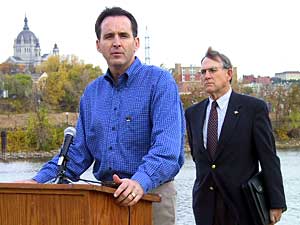|
Audio
Photos
More from MPR
Resources
Your Voice
|
Pawlenty wants to expand wetland conservation program
October 13, 2003
St. Paul, Minn. — (AP) - Farmers working land along the state's three major rivers would be paid to set aside up to 100,000 acres to improve water quality by curbing runoff while restoring wildlife habitat, Gov. Tim Pawlenty announced on Monday.
"We have more fresh water than any other state in the continental United States," Pawlenty said. "Protecting and restoring this crown jewel of our quality of life should be our number one environmental priority."
The $226 million proposal, which includes local, state and federal money, is the centerpiece of a clean water initiative Pawlenty outlined in June. It would expand the Conservation Reserve Enhancement Program in Minnesota to improve the state's waterways.
|
During the Pawlenty administration, they've taken about 1,000 steps backward regarding water quality. Now, he takes a half step forward and he wants to step up for applause.
- State Rep. Jean Wagenius, DFL-Minneapolis |
Three areas of the state are targeted in the proposal, which will be submitted to U.S. Secretary of Agriculture Ann M. Veneman this week. It focuses on restoring 42,500 acres in the Red River Watershed in the northwest, 42,500 acres in the lower Mississippi River watershed in the southeast and 15,000 acres in the Missouri River watershed in southwest Minnesota.
If the proposal is approved by the U.S. Department of Agriculture, $180 million would come from that agency, with $46 million in state and local money. For the state's side, Pawlenty wants the Legislature to bond for $23 million in 2004 and the same amount two years later.
"I think legislators would be remiss if they didn't include this" (in the bonding bill), Pawlenty said.
State Rep. Jean Wagenius, DFL-Minneapolis, wasn't impressed.
"The basic concern here is during the Pawlenty administration, they've taken about 1,000 steps backward regarding water quality," she said. "Now, he takes a half step forward and he wants to step up for applause."
While she doesn't oppose the CREP program, Wagenius said it's important to build in a way to measure results.
"Is this the best bang for your buck?" she said. "We cannot tell."
She thinks the state should monitor groundwater more frequently as well as taking a closer look at septic tanks, feedlots and wastewater treatment systems.
CREP is a voluntary program that works with farmers and ranchers to set aside marginal agricultural lands along waterways to enhance wildlife habitats, improve water quality, reduce erosion and sedimentation and reduce the effects of recurrent flooding.
Once the Agriculture Department has received Minnesota's proposal, the final details will be negotiated and agreed upon by both the state and the USDA. Farmers could begin voluntarily signing up to put their land in the program as early as March 2004. Landowners will have the choice of a 35-year or perpetual easement.
The national CREP program started in 1996 and Minnesota already has taken advantage of the program to improve water quality in the Minnesota River Basin.
(Copyright 2003 by The Associated Press. All Rights Reserved.)
|
News Headlines
|
Related Subjects
|

